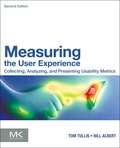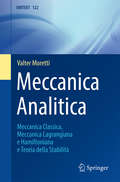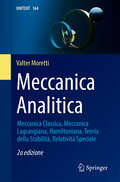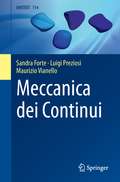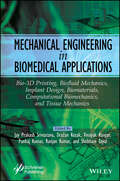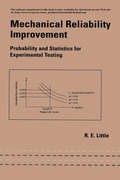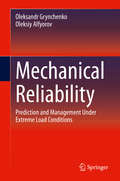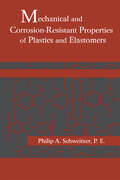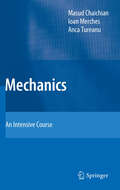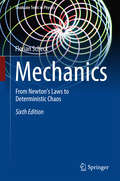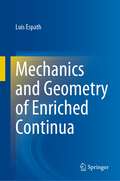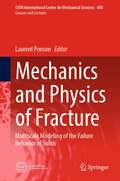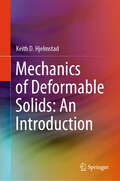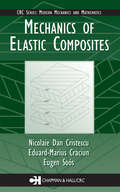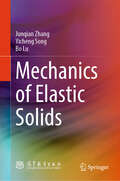- Table View
- List View
Measuring the User Experience: Collecting, Analyzing, and Presenting Usability Metrics (Second Edition)
by William Albert Thomas TullisMeasuring the User Experience was the first book that focused on how to quantify the user experience. Now in the second edition, the authors include new material on how recent technologies have made it easier and more effective to collect a broader range of data about the user experience. As more UX and web professionals need to justify their design decisions with solid, reliable data, Measuring the User Experience provides the quantitative analysis training that these professionals need. The second edition presents new metrics such as emotional engagement, personas, keystroke analysis, and net promoter score. It also examines how new technologies coming from neuro-marketing and online market research can refine user experience measurement, helping usability and user experience practitioners make business cases to stakeholders. The book also contains new research and updated examples, including tips on writing online survey questions, six new case studies, and examples using the most recent version of Excel. Learn which metrics to select for every case, including behavioral, physiological, emotional, aesthetic, gestural, verbal, and physical, as well as more specialized metrics such as eye-tracking and clickstream data. Find a vendor-neutral examination of how to measure the user experience with web sites, digital products, and virtually any other type of product or system. Discover in-depth global case studies showing how organizations have successfully used metrics and the information they revealed. Companion site, www. measuringux. com, includes articles, tools, spreadsheets, presentations, and other resources to help you effectively measure the user experience
Measuring up to the Common Core, Level C
by People'S EducationThis worktext is customized to the Common Core State Standards for Mathematics. Most lessons focus on one content standard for in-depth review. Mathematical Practices are interwoven throughout each lesson to connect practices to content at point-of-use and promote depth of understanding.
Meccanica Analitica: Meccanica Classica, Meccanica Lagrangiana e Hamiltoniana e Teoria della Stabilità (UNITEXT #122)
by Valter MorettiIl testo parte da una rivisitazione teorica della meccanica classica newtoniana e del suo linguaggio matematico che si conclude con un'analisi critica della meccanica classica newtoniana. Si passa quindi alle formulazioni lagrangiane e hamiltoniane della meccanica classica, discutendo in particolare il rapporto tra simmetrie e costanti del moto all'interno di varie versioni del teorema di Noether e analoghi risultati. I capitoli sulla meccanica hamiltoniana, oltre al materiale standard come le parentesi di Poisson, la geometria simplettica, la formulazione di Hamilton-Jacobi e principi variazionali, includono alcuni risultati teorici importanti come il teorema di Liouville e il teorema di ricorrenza di Poincaré. La teoria della stabilità è introdotta e discussa nell'approccio di Liapunov. Il linguaggio adottato in tutto il testo è quello della geometria differenziale, che in ogni caso viene introdotta gradualmente. Un complemento finale include la teoria di base dei sistemi di equazioni differenziali ordinarie e dei sistemi con alcune generalizzazioni alla teoria sulle varietà. Diverse appendici introducono alcuni strumenti matematici come la teoria delle forme differenziali, la derivata di Lie e la teoria dell'integrazione su varietà. Il libro include diversi esercizi risolti.Il libro si rivolge agli studenti di Matematica e Fisica per i corsi di Meccanica Razionale e Meccanica Analitica.
Meccanica Analitica: Meccanica Classica, Meccanica Lagrangiana, Hamiltoniana, Teoria della Stabilità, Relatività Speciale (UNITEXT #164)
by Valter MorettiIl testo parte da una rivisitazione teorica della meccanica classica newtoniana e del suo linguaggio matematico che si conclude con un'analisi critica della meccanica classica newtoniana. Si passa quindi alle formulazioni lagrangiane e hamiltoniane della meccanica classica, discutendo in particolare il rapporto tra simmetrie e costanti del moto all'interno di varie versioni del teorema di Noether e analoghi risultati. I capitoli sulla meccanica hamiltoniana, oltre al materiale standard come le parentesi di Poisson, la geometria simplettica, la formulazione di Hamilton-Jacobi e principi variazionali, includono alcuni risultati teorici importanti come il teorema di Liouville e il teorema di ricorrenza di Poincaré. La teoria della stabilità è introdotta e discussa nell'approccio di Lyapunov. Nella seconda edizione è stata aggiunta una descrizione matematica della teoria della relatività speciale e di alcuni suoi sviluppi nell'ambito della formulazione lagrangiana ed hamiltoniana. Il linguaggio adottato in tutto il testo è quello della geometria differenziale, che in ogni caso viene introdotta gradualmente. Un primo complemento finale discute gli assiomi fisici su cui si basa la teoria della relatività speciale e come si passa da tali assiomi alla formulazione matematica. Un secondo complemento include la teoria di base dei sistemi di equazioni differenziali ordinarie e dei sistemi con alcune generalizzazioni alla teoria sulle varietà. Diverse appendici introducono alcuni strumenti matematici come la teoria delle forme differenziali, la derivata di Lie e la teoria dell'integrazione su varietà. Il libro include diversi esercizi risolti. Il libro si rivolge agli studenti di Matematica e Fisica per i corsi di Meccanica Razionale e Meccanica Analitica.
Meccanica dei Continui (UNITEXT #114)
by Luigi Preziosi Sandra Forte Maurizio VianelloLa finalità del libro è quella di presentare i concetti di base della Meccanica dei Continui a studenti che frequentano sia corsi di laurea che corsi di dottorato in Matematica, Fisica e Ingegneria. Questo obiettivo è perseguito da una parte limitando per quanto possibile i prerequisiti culturali necessari per la comprensione della materia e dall’altra mantenendo un linguaggio sì rigoroso, ma anche semplice e colloquiale. In questo modo il testo risulta adatto anche agli studenti che per la prima volta si interessano alla Meccanica dei Continui e che non hanno conoscenze pregresse specifiche. <p><p> Nella presentazione di ogni argomento gli aspetti teorici sono corredati di esempi ed esercizi, tutti svolti. Inoltre, pur mantenendo la tradizionale e irrinunciabile struttura ipotetico-deduttiva, il libro presenta, soprattutto nei capitoli finali dedicati ai solidi e ai fluidi, una attenzione particolare alle applicazioni che gli studenti potrebbero incontrare in altri insegnamenti.
Mechanical Engineering in Biomedical Application: Bio-3D Printing, Biofluid Mechanics, Implant Design, Biomaterials, Computational Biomechanics, Tissue Mechanics
by Pankaj Kumar Shubham Tayal Jay Prakash Srivastava Vinayak Ranjan Ranjan Kumar Dražan KozakMECHANICAL ENGINEERING IN BIOMEDICAL APPLICATIONS The book explores the latest research and developments related to the interdisciplinary field of biomedical and mechanical engineering offering insights and perspectives on the research, key technologies, and mechanical engineering techniques used in biomedical applications. The book is divided into several sections that cover different aspects of mechanical engineering in biomedical research. The first section focuses on the role of additive manufacturing technologies, rehabilitation in healthcare applications, and artificial recreation of human organs. The section also covers the advances, risks, and challenges of bio 3D printing. The second section presents insight into biomaterials, including their properties, applications, and fabrication techniques. The section also covers the use of powder metallurgy methodology and techniques of biopolymer and bio-ceramic coatings on prosthetic implants. The third section covers biofluid mechanics, including the mechanics of fluid flow within our body, the mechanical aspects of human synovial fluids, and the design of medical devices for fluid flow applications. The section also covers the use of computational modeling to study the blockage of carotid arteries. The final section elaborates on soft robotic manipulation for use in medical sciences. Audience The book provides practical insights and applications for mechanical engineers, biomedical engineers, medical professionals, and researchers working on the design and development of biomedical devices and implants.
Mechanical Reliability Improvement: Probability and Statistics for Experimental Testing
by Robert LittleProviding probability and statistical concepts developed using pseudorandom numbers, this book covers enumeration-, simulation-, and randomization-based statistical analyses for comparison of the test performance of alternative designs, as well as simulation- and randomization-based tests for examination of the credibility of statistical presumptions. The book discusses centroid and moment of inertia analogies for mean and variance and the organization structure of completely randomized, randomized complete block, and split spot experiment test programs. Purchase of the text provides access to 200 microcomputer programs illustrating a wide range of reliability and statistical analyses.
Mechanical Reliability: Prediction and Management Under Extreme Load Conditions
by Oleksandr Grynchenko Oleksiy AlfyorovThe volume describes the main theoretical propositions of the methodology to predict mechanical reliability under conditions of repeated exposure to random extreme loads. The mechanical load process is considered to be a form of a discrete sequence of loads occurring at times that form a random flow. The authors present solved problems of reliability prediction of elements having deterministic or random bearing capacity. A method for the probabilistic justification of safety factors is also developed in the book, providing a predetermined level of reliability of elements and systems for sudden failures during design. It considers the methods of prediction and managing reliability under conditions of using safety devices. The main theoretical results are presented in a form available for practical engineering applications. The book can be used by researchers and as a manual by teachers and graduate students of higher technical educational institutions.
Mechanical and Corrosion-Resistant Properties of Plastics and Elastomers
by Philip A. SchweitzerA study of the physical, mechanical and corrosion resistant properties of all the most common commercially available plastics and elastomers. It offers examples of typical applications and describes methods of joining. The physical, mechanical and corrosion resistant properties of 32 thermoplastics, 20 thermosets, and 27 elastomers are provided. Th
Mechanics
by Masud Chaichian Anca Tureanu Ioan MerchesMechanics is one of the oldest and at the same time newest disciplines, in the sense that there are methods and principles developed first in mechanics but now widely used in almost all branches of physics: electrodynamics, quantum mechanics, classical and quantum field theory, special and general theory of relativity, etc. More than that, there are some formalisms like Lagrangian and Hamiltonian approaches, which represent the key stone for the development of the above-mentioned disciplines. During the last 20-25 years, classical mechanics has undergone an important revival associated with the progress in non-linear dynamics, applications of Noether's theorem and the extension of variational principles in various interdisciplinary sciences (for instance, magnetofluid dynamics). Thus, there ought to exist a book concerned with the applied analytical formalism, first developed in the frame of theoretical mechanics, which has proved to be one of the most efficient tools of investigation in the entire arena of science.The present book is an outcome of the authors' teaching experience over many years in different countries and for different students studying diverse fields of physics. The book is intended for students at the level of undergraduate and graduate studies in physics, engineering, astronomy, applied mathematics and for researchers working in related subjects. We hope that the original presentation and the distribution of the topics, the various applications in many branches of physics and the set of more than 100 proposed problems, shall make this book a comprehensive and useful tool for students and researchers. The present book is an outcome of the authors' teaching experience over many years in different countries and for different students studying diverse fields of physics. The book is intended for students at the level of undergraduate and graduate studies in physics, engineering, astronomy, applied mathematics and for researchers working in related subjects. We hope that the original presentation and the distribution of the topics, the various applications in many branches of physics and the set of more than 100 proposed problems, shall make this book a comprehensive and useful tool for students and researchers.
Mechanics
by Florian ScheckPurpose and Emphasis. Mechanics not only is the oldest branch of physics but was and still is the basis for all of theoretical physics. Quantum mechanics can hardly be understood, perhaps cannot even be formulated, without a good knowledge of general mechanics. Field theories such as electrodynamics borrow their formal framework and many of their building principles from mechanics. In short, throughout the many modem developments of physics where one fre quently turns back to the principles of c1assical mechanics its model character is feIt. For this reason it is not surprising that the presentation of mechanics reflects to some extent the development of modem physics and that today this c1assical branch of theoretical physics is taught rather differently than at the time of Arnold Sommerfeld, in the 1920s, or even in the 1950s, when more emphasis was put on the theory and the applications of partial-differential equations. Today, symme tries and invariance principles, the structure ofthespace-time continuum, and the geometrical structure of mechanics play an important role. The beginner should realize that mechanics is not primarily the art of describing block-and-tackles, coIIisions of billiard balls, constrained motions of the cylinder in a washing ma chine, or bicycle riding.
Mechanics and Geometry of Enriched Continua
by Luis EspathThis monograph presents a comprehensive and rigorous new framework for the theoretical description and modelling of enriched continua. In other words, continua that exhibit more complex behaviour than their conventional counterparts and, in particular, multicomponent systems. It employs gradient theories, exhibiting multiple transition layers described by phase fields. As a point of departure, we account for multiple continuum kinematic processes, including motion and various phase fields. These gradient theories arise by considering various kinematic processes which are tightly linked to the level of the arbitrariness of the Euler–Cauchy cuts. The surface defining the Euler–Cauchy cut may lose its smoothness along a curve, and the curve may also lose its smoothness at a point. Additionally, we postulate the principle of virtual power on surfaces. Then, the first and second laws of thermodynamics with the power balance provide suitable and consistent choices for the constitutive equations. Finally, the complementary balances, namely the balances on surfaces, are tailored to coincide with different parts of the boundaries of the body. These surface balances are then called environmental surface balances and aid in determining suitable and consistent boundary conditions. Ultimately, the environmental surface power balance is relaxed to yield an environmental surface imbalance of powers, rendering a more general type of boundary condition.A detailed introduction sets the scene for the mathematical chapters that follow, ensuring that graduate students and newcomers can profit from the material presented.
Mechanics and Physics of Fracture: Multiscale Modeling of the Failure Behavior of Solids (CISM International Centre for Mechanical Sciences #608)
by Laurent PonsonThe volume provides a comprehensive understanding of the macroscopic failure behavior of solids from the description of the microscopic failure processes and their coupling with the microstructure. Several fundamental questions were addressed: the relation between the microstructural features of materials and their fracture properties and crack trajectories; the role of damage mechanisms and non-linear deformations near the crack tip on the failure behavior of solids; and finally the role of dynamic inertial effects during fast fracture was more briefly evoked. The chapters provide a pedagogical overview of recently developed concepts and tools, that permit to perform the transition from small scales to large ones in fracture problems, thus introducing basic rules for the rational design of tough solids.
Mechanics of Deformable Solids: An Introduction
by Keith D. HjelmstadThis book provides a fresh approach to learning how solid bodies respond to loads, emphasizing clear derivations of the basic concepts from first principles. A consistent problem-solving framework fosters understanding by building and reinforcing the mathematical tools best suited to the task. Theoretical developments are augmented by an extensive set of MATLAB codes that not only show how to organize computations but also yield powerful tools for exploration and discovery. The book is aimed at engineering students at the sophomore level who have a background in calculus, linear algebra, and differential equations.
Mechanics of Elastic Composites
by Nicolaie Dan Cristescu Eduard-Marius Craciun Eugen SoósThis is a comprehensive, reader-friendly treatment of the theory behind modern elastic composite materials. The treatment includes recently developed results and methods drawn from research papers published in Eastern Europe that until now were unavailable in many western countries. Among the book's many notable features is the inclusion of more th
Mechanics of Elastic Solids
by Bo Lu Junqian Zhang Yicheng SongThis book entitled Mechanics of Elastic Solids is written as a textbook of the course “Elasticity” or “Theory of Elasticity” or “Elasticity Mechanics” for relevant engineering majors. It can also be used as a professional book for relevant technical persons. It mainly introduces elasticity theory, including stress analysis, deformation analysis, constitutive relations, elasticity model construction for actual problems, solutions for infinitesimal plane stress and strain problems, three-dimensional problems, multiphysics field problems, variation principle in elasticity, thin plate, and cylindrical shells. The rapid and continuous advancements in numerical methods and computer power have diminished the significance of certain analytical solutions in elasticity problems.. Therefore, this book simplifies some traditional contents such as the solution of plane problems and twist of cylinder. Instead, some new topics which are important for real-world problems are introduced, such as the accurate description of finite deformation, constitutive equations for small strain but large rotation problems, hyperelasticity, procedural steps and general methodologies for model construction of real-world problems, and multiphysics field problems. A plenty of examples is prepared in this book for comprehensive understanding.
Mechanics of Strain Gradient Materials (CISM International Centre for Mechanical Sciences #600)
by Samuel Forest Albrecht BertramOver the past 50 years, strain gradient material theories have been developed for the continuum modeling of size effects in materials and structures in terms of their elasticity, plasticity and fracturing. This book puts forward a unifying perspective to combine existing theories involving the higher order gradient of the strain tensor, or of plastic strain. It begins by reviewing experimental findings on the existence (or non-existence) of size effects on the mechanics of materials. In turn, the book devises first, second and higher order strain gradient theories from general principles, and presents constitutive frameworks that satisfy thermodynamic requirements. The special case of strain gradient plasticity is then developed and illustrated via computational analyses of size effects on the plasticity of metals at small scales. In closing, the book explains the origin of gradient effects in the case of lattice structures by drawing on homogenization theory.
Mechanics of Structures: Variational and Computational Methods
by Walter D. Pilkey Walter WunderlichResoundingly popular in its first edition, the second edition of Mechanics of Structures: Variational and Computational Methods promises to be even more so, with broader coverage, expanded discussions, and a streamlined presentation.The authors begin by describing the behavior of deformable solids through the differential equations for the
Mechanik für das gymnasiale Lehramt: Theoretische Physik und mathematische Methoden klar erklärt
by Hendrik van HeesDieses Lehrbuch in drei Bänden führt in die Standardinhalte der Vorlesungen über Theoretische Physik (klassische Mechanik, Elektrodynamik und Quanten- und Relativitätstheorie) unter besonderer Berücksichtigung der speziellen Bedürfnisse von Lehramtsstudierenden ein. Im Vordergrund stehen dabei die grundlegenden Konzepte basierend auf Symmetrieprinzipien. Der vorliegende 1. Band behandelt die Newtonsche und analytische Mechanik. Besonderheiten Die konzeptionellen Grundlagen der klassischen Mechanik, insbesondere die mathematische Beschreibung von Raum und Zeit sowie der Begriff des Inertialsystems werden sorgfältig herausgearbeitet. Die für das Verständnis der theoretischen Physik unabdingbaren mathematischen Methoden werden parallel zu den eigentlichen physikalischen Lernhinhalten bereitgestellt und alle Rechnungen mit ausführlichen Zwischenschritten vollständig ausgeführt. Neben einer ausführlichen Behandlung der Newtonschen Mechanik mit den üblichen Beispielen zum freien Fall in Erdnähe, dem harmonischen Oszillator und dem Kepler-Problem der Planetenbewegung nimmt das Hamiltonsche Prinzip der kleinsten Wirkung und die ausführliche Behandlung der Symmetrieprinzipien und des Noether-Theorems einen breiten Raum ein. Dies ermöglicht ein vertieftes Verständnis für die moderne Beschreibung der Naturgesetze und erleichtert den Einstieg für die weiterführenden Vorlesungen beträchtlich, insbesondere der Quanten- und Relativitätstheorie. Inhalt 1. Kinematik und Dynamik der Newtonschen Mechanik und Erhaltungssätze, 2. Newtonsches Gravitationsgesetz und Himmelsmechanik, 3. Bewegung in beschleunigten Bezugssystemen, 4. Analytische Mechanik und das Noether-Theorem in Lagrangescher und Hamiltonscher Formulierung, 5. Anwendungen auf die Bewegung starrer Körper und Kreiseltheorie. Zielgruppe Das Buch richtet sich an Bachelor-Studierende der Physik und im Besonderen an Studierende der Physik für das Gymnasiallehramt. Dabei wird dem besonderen Bedarf dieser Zielgruppe einer möglichst einfachen Einführung in die mathematischen Methoden Rechnung getragen. Vorkenntnisse Vorausgesetzt werden Grundkenntnisse der Analysis, der linearen Algebra und der klassischen Mechanik und Eektrodynamik auf Abiturniveau.
Mechanik – smart gelöst
by Peter KerstenDieses Buch bietet Studierenden in MINT-Fächern eine optimale Hilfestellung beim Erlernen der Grundlagen der Physik. Typische Aufgaben der Mechanik werden dabei Schritt für Schritt erklärt und mit Hilfe leistungsstarker Software aus den Bereichen Tabellenkalkulation, Computeralgebra und technisch-wissenschaftlichem Rechnen gelöst. Die dabei verwendeten Programme (Excel®, der Internetdienst Wolfram|Alpha® sowie die Software MATLAB®) sind sowohl auf Desktop-Rechnern, als auch als Apps auf mobilen Endgeräten wie Smartphones oder Tablets verfügbar – und damit immer schnell zur Hand. Das Fähigkeit mit diesen Programmen zu arbeiten kann auch im weiteren Studienverlauf und später in der beruflichen Praxis von großen Nutzen sein. Nach einer kompakten Einführung in mathematische Methoden und die verwendeten Programme deckt das Buch dabei die Bereiche der klassischen Mechanik mit den Teilgebieten Kinematik und Dynamik ab und liefert somit eine ideale Unterstützung für Einführungsvorlesungen in Physik an Hochschulen. Allen Studierenden, die sich beim Lösen von Aufgaben in der Physik schon einmal eine kleine Hilfestellung gewünscht haben, die einfach mal einen Funktionsverlauf visualisieren, eine Gleichung ohne Papier und Bleistift lösen oder das eigene Rechenergebnis überprüfen möchten, wird das vorliegende Buch ein praktischer und wertvoller Begleiter sein.
Mechanism Design: A Linear Programming Approach
by Rakesh V. VohraMechanism design is an analytical framework for thinking clearly and carefully about what exactly a given institution can achieve when the information necessary to make decisions is dispersed and privately held. This analysis provides an account of the underlying mathematics of mechanism design based on linear programming. Three advantages characterize the approach. The first is simplicity: arguments based on linear programming are both elementary and transparent. The second is unity: the machinery of linear programming provides a way to unify results from disparate areas of mechanism design. The third is reach: the technique offers the ability to solve problems that appear to be beyond solutions offered by traditional methods. No claim is made that the approach advocated should supplant traditional mathematical machinery. Rather, the approach represents an addition to the tools of the economic theorist who proposes to understand economic phenomena through the lens of mechanism design.
Mechanism of Hairpin Vortex Formation by Liutex (Synthesis Lectures on Engineering, Science, and Technology)
by Chaoqun Liu Yifei YuThis book presents the importance of the mechanism of hairpin vortex formation to understanding flow transition, turbulence, and flow control. This book blends direct numerical simulation (DNS) and mathematical analysis with experiments to create a foundation for understanding turbulence. The authors discuss hairpin vortex as a main component of transitional flow and turbulent flow. In addition, Liutex is utilized and described as a theoretical system that presents valid tools for turbulence research. Readers are exposed to understanding 3D and non-linear instability; the Lambda vortex formation; sweeps, ejections, and shear instability; the Kelvin-Helmholtz instability and vortex ring formation; and turbulence generation and sustenance.
Mechanisms for Generating Mathematical Curves (Springer Tracts in Mechanical Engineering)
by Dan B. Marghitu Iulian Popescu Liliana Luca Mirela CherciuThis book focuses on important mathematical considerations in describing the synthesis of original mechanisms for generating curves. The synthesis is manual and not based on the use of computer tools. Kinematics is applied to confirm the drawing of the curves, and the closed loop method, and in some cases the distances method, is applied in this phase. The book provides all the notions of structure and kinematics that are necessary to calculate the mechanisms and also analyzes other kinematic possibilities of the created mechanisms. Offering a concise, yet self-contained guide to the mathematical fundamentals for mechanisms of curve generation, together with a useful collection of mechanisms exercises, the book is intended for students learning about mechanism kinematics, as well as engineers dealing with mechanism design and analysis. It is based on the authors’ many years of research, which has been published in different books and journals, mainly, but not exclusively, in Romanian.
Mechanisms of Cracking and Debonding in Asphalt and Composite Pavements: State-of-the-art Of The Rilem Tc 241-mcd (RILEM State-of-the-Art Reports #28)
by Gabriele Tebaldi William G. Buttlar Armelle Chabot Eshan V. Dave Christophe PetitPremature cracking in asphalt pavements and overlays continues to shorten pavement lifecycles and creates significant economic and environmental burden. In response, RILEM Technical Committee TC 241-MCD on Mechanisms of Cracking and Debonding in Asphalt and Composite Pavements has conducted a State-of-the-Art Review (STAR), as detailed in this comprehensive book. Cutting-edge research performed by RILEM members and their international partners is presented, along with summaries of open research questions and recommendations for future research. This book is organized according to the theme areas of TC 241-MCD - i.e., fracture in the asphalt bulk material, interface debonding behaviour, and advanced measurement systems. This STAR is expected to serve as a long term reference for researchers and practitioners, as it contributes to a deeper fundamental understanding of the mechanisms behind cracking and debonding in asphalt concrete and composite pavement systems.
Mechanistic Data Science for STEM Education and Applications
by Wing Kam Liu Zhengtao Gan Mark FlemingThis book introduces Mechanistic Data Science (MDS) as a structured methodology for combining data science tools with mathematical scientific principles (i.e., “mechanistic” principles) to solve intractable problems. Traditional data science methodologies require copious quantities of data to show a reliable pattern, but the amount of required data can be greatly reduced by considering the mathematical science principles. MDS is presented here in six easy-to-follow modules: 1) Multimodal data generation and collection, 2) extraction of mechanistic features, 3) knowledge-driven dimension reduction, 4) reduced order surrogate models, 5) deep learning for regression and classification, and 6) system and design. These data science and mechanistic analysis steps are presented in an intuitive manner that emphasizes practical concepts for solving engineering problems as well as real-life problems. This book is written in a spectral style and is ideal as an entry level textbook for engineering and data science undergraduate and graduate students, practicing scientists and engineers, as well as STEM (Science, Technology, Engineering, Mathematics) high school students and teachers.
